
‘Condo Beyond the Minimum’: Paul’s ART STUFF ON A TRAIN #148
Mathis Altmann: ‘Fresh Breeze, Old Smell’, 2015 – concrete, metal, wood, mini-cam, lcd-screen, plastic, paper, cold-cathode lamps, electrical fan, carton, plexiglass
CONDO is a tidy concept: instead of struggling to meet the fixed costs of attending an Art Fair and then facing the pressure to sell which comes with that, 16 young foreign* galleries have been invited to share the space of 8 emerging London galleries, so that 24 galleries are represented in a four week festival-come-fair (to 13 Feb – www.condocomplex.org).
There was certainly a buzz when matters got under way on 16th January, when all eight spaces were crowded. and gallerists have told me since that visitors have been double the usual numbers.
My favourite pairing was at the newest gallery, Chewday’s in Vauxhall – run by Tobias Czudej, who didn’t want a tricky name to stand in the way – with Berlin’s Kraupa Tuskany-Zeidler, who didn’t, I guess, share that concern. The host’s Nicholas Cheveldave’s painting-collages festooned with webs made from friendship bracelets (how we’re trapped in social media?) meet Daniel Keller’s 3D printed digitally sliced riffs on the cairn (ancient meets modern, inter-personal is folded into the techno-corporate?) and that felt like a natural attachment. My other highlight – every home should have one – was Mathis Altmann’s weirdly atmospheric pseudo-machines with live-stream views into their concrete innards (from Supplement’s Genevan guest Truth and Consequences), one of which made a smell via oil-powering of its primitive fan. All eight spaces were lively, though, and it seems a repeatable experiment, perhaps to be hosted in alternating cities.
* Actually one of sixteen was Seventeen, so I’m counting Haggerston as foreign territory.
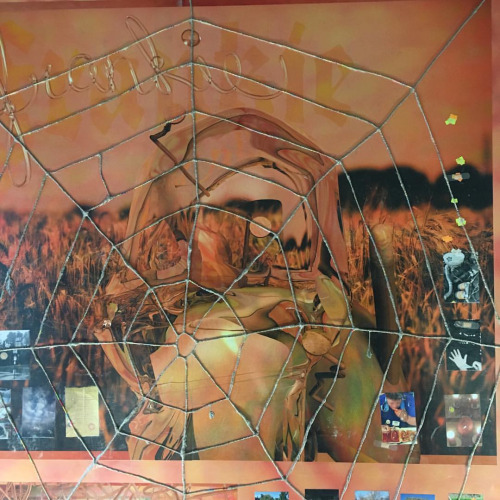
Nicholas Cheveldave ‘Funny Boy (detail)’. 2015
Paul’s ART STUFF ON A TRAIN #149: ‘Intersect’

Park McArthur at Chisenhale Gallery, photo by Mark Blower
Not many exhibitions have a direct connection to the role for which I spend time on the train, but at the centre of Park McArthur’s fascinating UK debut (‘Poly’ at the Chisenhale Gallery to 3 April) is a letter from the Department of Work and Pensions. It announces the closure of the Independent Living Fund – which helps people with disabilities to live independently – in favour of new local arrangements. That’s relevant to my day-job*, to McArthur as a disability justice activist, and to the rest of the show. That’s a polyphony of polymers through which she says she wanted to think about pressure – and absorbing and expelling – in terms of the body; in materials like foam; and at the level of the millions of people expelled and absorbed through various kinds of social and economic regimes.
What do we see? A series of steel trays set atop plinths group disposable manufactured items which operate at the points of contact of bodies with each other or with their environment – such as condoms, incontinence pads, dental dams and medical breathing tubes. That suggests medical vulnerability and the potential for polymorphous contact and collective action, as well as how the DWP interfaced with people as bodies for the purposes of assessing ILF entitlement. We also encounter monumental blocks of acoustic foam; and sheets of paper pulp blooming after months of drying with the growths from a polymer powder which enabled them to take in huge amounts of water. For sounds, liquids, bodies and bureaucrats alike, it’s an absorbing show.
* Policy Manager for Health, Social Care and Welfare Reform at the Chartered Institute of Public Finance and Accountancy

Park McArthur at Chisenhale Gallery, Photo by Mark Blower
Paul’s ART STUFF ON A TRAIN #147: ‘Questions Not Related to Nigella’
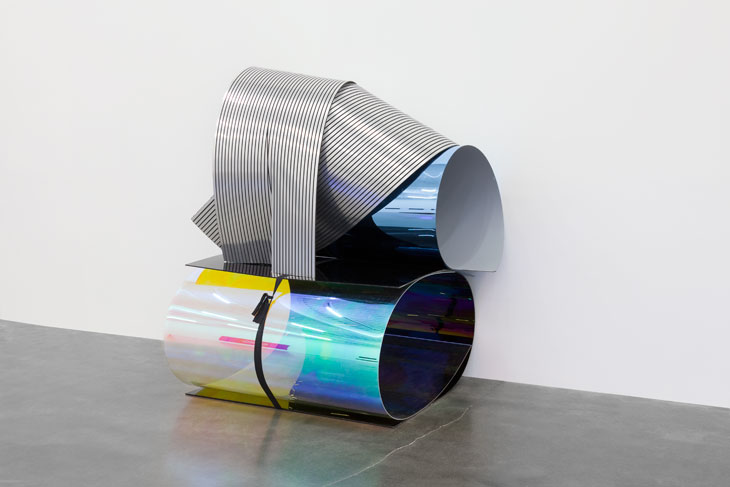
Julia Dault: ‘Untitled 19, 10:27 AM–1:13 PM, January 5, and 5:08–6:48 PM, January 6, 2016, installed by Simon Bird’, 2012 – Plexiglas, Tambour, Everlast boxing wraps, string
How many women have to be in a women-only show for it to look like a statement rather than a show which happens to feature female artists? Surely fewer than the 14 in Saatchi’s latest display, titled Champagne Life in half-irony, half obeisance to the sponsor’s Pommery fizz, which I was happy enough to enjoy at the opening. If it’s a statement, though, it’s unclear what that might amount to in this disparate show.
How hard can it be to install work in such a large and well-tested space? Pretty hard in the case of Alice Anderson’s 3.5m high bobbin: both the lift and the work had to be partly deconstructed to get it in. That was worthwhile, though, for the egg-umbilical fairytale Freudianism of her biggest copper thread mummifications yet.
Is the point of such shows to facilitate photo opportunities? Maybe: the high proportion of selfie-friendly works here also include cows, equines, giant body and face magnifications and a wall of battered pans to pose before.
Is this fairly random mix worth visiting? I’d say yes, mainly by adding Anderson and Wachtel to Julia Dault’s coiled supressions of energy, Mequitta Ahuja’s dramatic layering of paper grounds and Sigrid Holmwood’s psychedelic take on 19th century peasant life.
Why hasn’t Holmwood used fluorescent paint since this series? They were too saleable, she told me: no champagne life for her, she needs to suffer for her art.
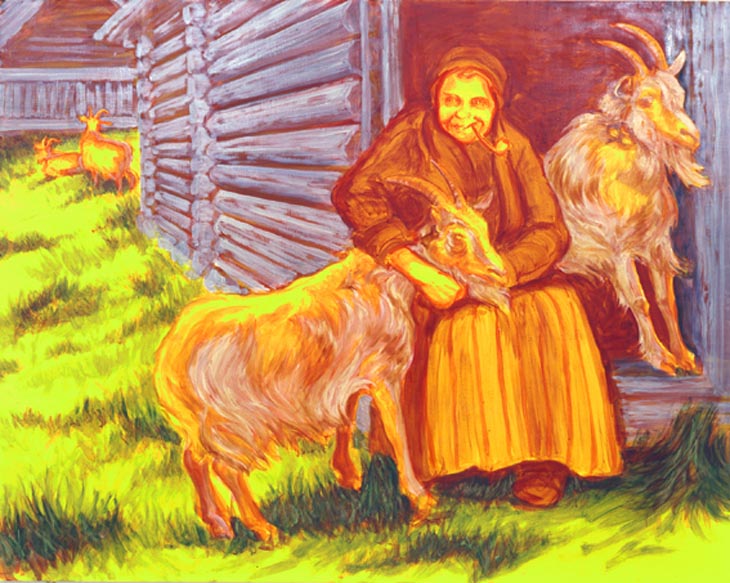
Sigrid Holmwood: ‘Old Woman Hugging A Goat’, 2008 – Fluorescent lemon yellow, fluorescent flame red, lead white, cochineal, ultramarine, green earth, Spanish red ochre in egg tempera and oils on board
Most days art Critic Paul Carey-Kent spends hours on the train, traveling between his home in Southampton and his day job in London. Could he, we asked, jot down whatever came into his head?
Paul’s ART STUFF ON A TRAIN #146:
‘City of Faces’
 |
| Francisco José de Goya y Lucientes: ‘Portrait of Doña Antonia Zárate’, c. 1805-1806 |
London’s museums have been awash with portraits recently. That’s to
be expected at the National Portrait Gallery, though less so in a show
about Giacometti. Yet that (to 10th Jan) was rendered no less intense by
its weighting away from sculpture. The Photographic Portrait prize show
(to 21st Feb) features curious choices as winners, but is overall (as
usual) better than the NPG’s painting equivalent – especially as Pieter
Hugo appears as a ‘special guest’. Jean-Etiene Liotard at the RA (to
31st Jan) shows himself a superior ‘painter’ in in the pastels for which
he’s famous than in the surprisingly numerous oils on show. Liotard’s
chalked faces take on a sepulchral luminosity regardless of how
realistically he anatomises his sitters’ imperfections, whereas oils
emerge rather dulled from the same touch. The V&A has the substantial display ‘Facing History: Contemporary
Portraiture’, and you might also count Julia Margaret Cameron (V&A
and Science Museums to 21st Feb) and Frank Auerbach (Tate Britain to
14th Feb) but I’d say it’s stretching these fine shows to call them
portraiture. The daddy of them all, though, was Goya’s Portraits at the
National Gallery (also to 10 Jan). Even those to whom that sounded the
dullest stream of work by ‘the first modern painter’ tended to be won
over by the history of Goya’s troubled times and his bravura brushwork,
the close-up effects of which are often quite abstract.

Alberto Giacometti: ‘Bust of Annette’, 1954
Most days art Critic Paul Carey-Kent spends hours on the train, traveling between his home in Southampton and his day job in London. Could he, we asked, jot down whatever came into his head?
Paul’s ART STUFF ON A TRAIN #145: ‘Spirit Power In Focus – and Out’
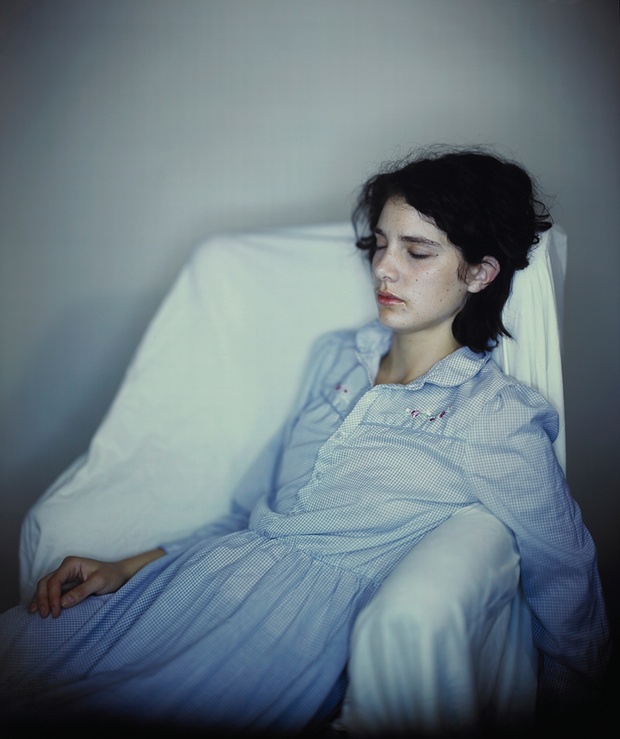
Richard Learoyd: ‘Agnes with Eyes Closed’, 2007 – Dye destruction print
There’s an unofficial festival of photography in Kensington just now. The V&A and the Science Museum both have substantial shows well into the overhang year to commemorate the bicentenary of Julia Margaret Cameron. Almost all the 200+ odd prints across the shows are from 1664-75, ie from when she was given her first camera at 48 to her emigration to what was then Ceylon). The Science Museum also has a persuasive summary of Alec Soth’s work, with a room for each of his major projects to date, and the V&A adds a 19 photo retrospective of Richard Learoyd. Even the Natural History Museum weighs in with the Wildlife Photographer of the Year 2015-16. Cameron and Learoyd, in particular, share a lot. Both use demanding techniques which dictate the sizes of their prints (she the wet collodion process, which requires a glass plate to be coated with photosensitive chemicals and exposed in the camera when still damp, the glass negative returned to the darkroom to be developed, and prints made by placing the negative directly on to sensitised photographic paper and exposing it to sunlight; he the use of a room-sized camera obscura, so the subject, in another chamber with a lens dividing the rooms, is focused directly on to the paper). Both feature posed people as the subject of their best work without it ever really seeming that they are portraits. Both exploit variable focus strikingly. She was mocked for that, but we now expect such artistic effects. Either way, the energising effect is similar, and Learoyd’s work takes us back to Victorian spirit photography and the initial magical power of image capture.

Julia Margaret Cameron: ‘My Favorite Picture of All My Works. My Niece Julia, April 1867’
Most days art Critic Paul Carey-Kent spends hours on the train, traveling between his home in Southampton and his day job in London. Could he, we asked, jot down whatever came into his head?
Paul’s ART STUFF ON A TRAIN #143:
‘What Is and Is Not Present’
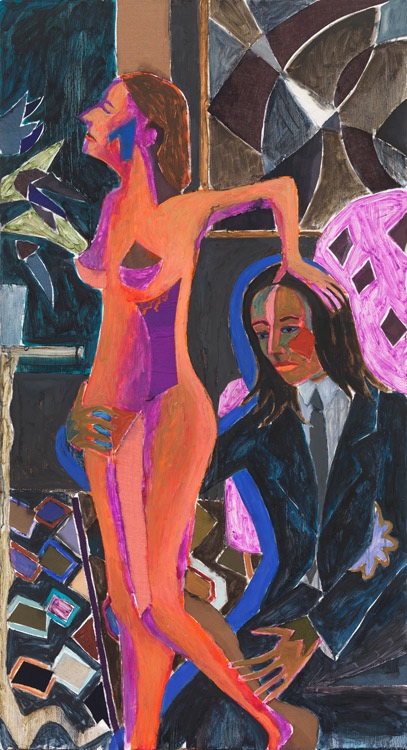
Armin Boehm: ‘Gravity’, 2015 – oil and fabrics on wood: 110 x 70 cm
Assessment of a curation has two halves: what is there, and what isn’t? On the one hand, one could criticise S|2’s ‘The Nude in the XX & XXI Century’ (to 15 Jan) as little more than an excuse to sell a raft of paintings which Sotheby’s happens to have on consignment; point out that curator Jane Neal’s four categories of the celebrated, feared, iconographic and reclaimed male nude are fairly loose and not followed through in how the work is displayed; and suggest that it would have been more interesting to add to the women in the show (especially Louise Bourgeois, Marlene Dumas and Caroline Walker) with, say, Sylvia Sleigh, Vanessa Beecroft, Mira Dancy, Ellen Altfest, Rebecca Warren and Marion Wagschall, so expanding the challenge to the tradition of the male gaze. On the other hand an attractive catalogue accompanies a fascinating mix of forty-odd works which also includes a radical Kees Van Dongen, two compellingly creepy paintings by Martin Eder and a chance to see Sue Webster and Tim Noble’s paintings of each other made with their feet (see https://vimeo.com/111293345). It’s also the first time I’ve seen Arin Boehm’s work in London: ‘Gravity’ is typical in showing a version of the Berliner himself acting out the suavely bohemian artist in a post-cubist space with fabric collage for emphasis. And I was struck by a jewel-like 6 x 9 inch Picasso oil of his sleeping Marie-Thérèse motif at its passionate height. So what is here is well worth seeing…
Pablo Picasso: ‘Femme Endormie’, 1933 – oil on canvas, 16 x 24 cm
Most days art Critic Paul Carey-Kent spends hours on the train, traveling between his home in Southampton and his day job in London. Could he, we asked, jot down whatever came into his head?
Paul’s ART STUFF ON A TRAIN #142: ‘Computers at Christmas’
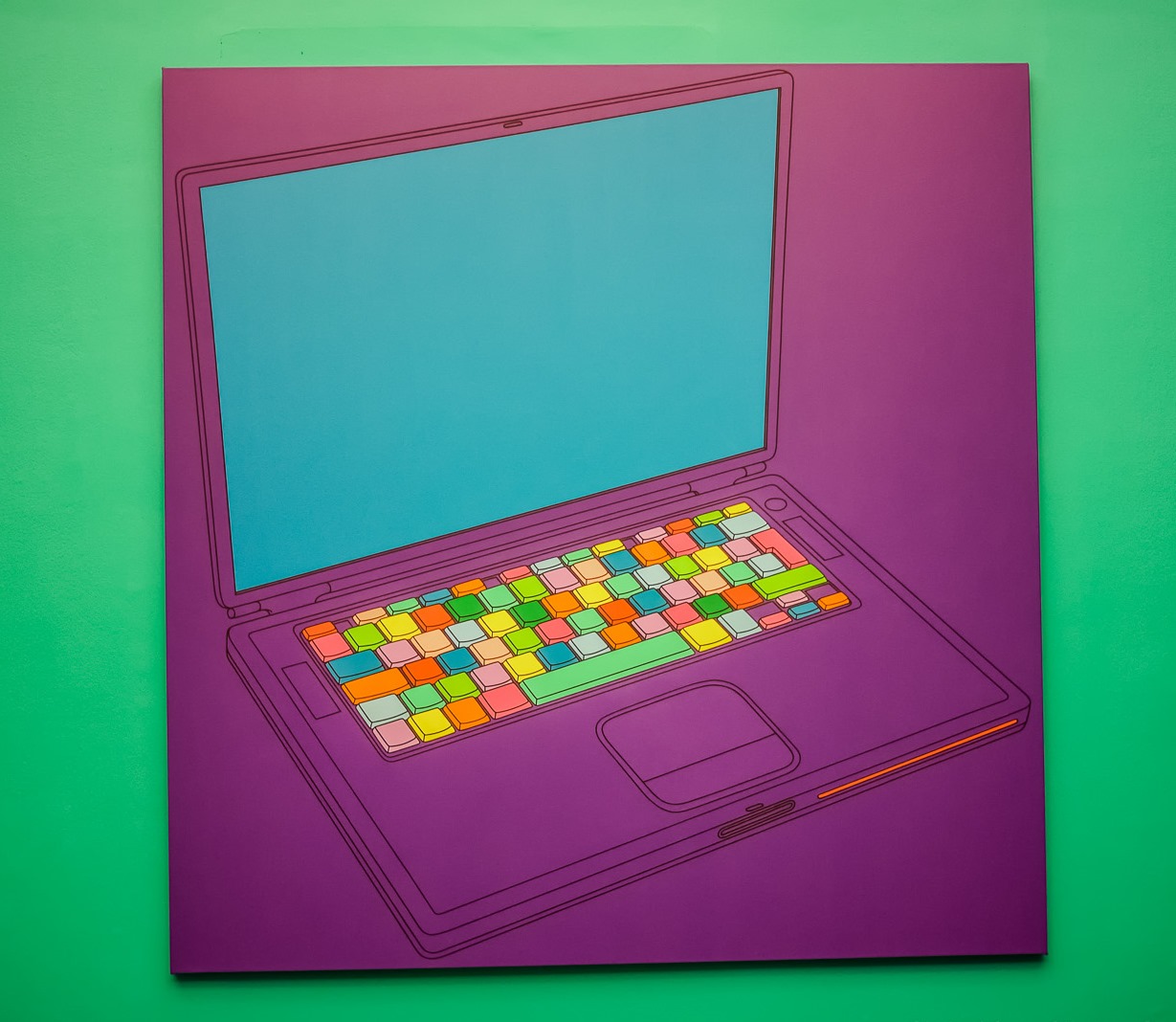
Michael Craig-Martin: ‘Apple 17inch Powerbook G4’ – Acrylic on canvas 2003
Anglo-American Michael Craig-Martin, with his biliously cool outlined objects, and former East German dissident A R Penck, with his cipher stickmen, have two of the most instantly recognisable painting styles around. Both show to advantage currently. In Craig-Martin’s case (‘Transience’ to 14 Feb), the scale of the Serpentine Gallery allows him to maximise the intensity of colour and vary his presentational tactics, while narrowing his focus to track changing technology. That triggers a memento mori path from bulbously redundant televisions to almost abstracted flatscreens, with nice little jokes thrown in. Is that credit card coloured as if ready to buy a Rothko? Are we to take trainers seriously as technology? What are those French fries doing here – are they a stand-in for computer chips? And why are they radioactively green – are French Fries that bad for you? The Penck show (‘Early Works’ at Michael Werner to 20 Feb) is more about showing his breadth. We see early paintings as his archetypes come into focus in the late sixties, and a good sample of his sculpture from the period, in which the accessible (and, consequently, crude and cheap) materials available to an unofficial artists behind The Wall translate to ramshackle range of anthropomorphic items. They now seem to criticise the crassness of communist life just as Craig-Martin deprecates the sleek triviality and passing fads of capitalism – just brought into focus by Christmas, I guess. Both artists can seem formulaic, but not here. Moreover, the two shows touch on a common subject: the computer keyboard…

AR Penck: ‘Primitive Computer’, 1968 – Oil on masonite
Paul’s ART STUFF ON A TRAIN #141: ‘Material Advantages’
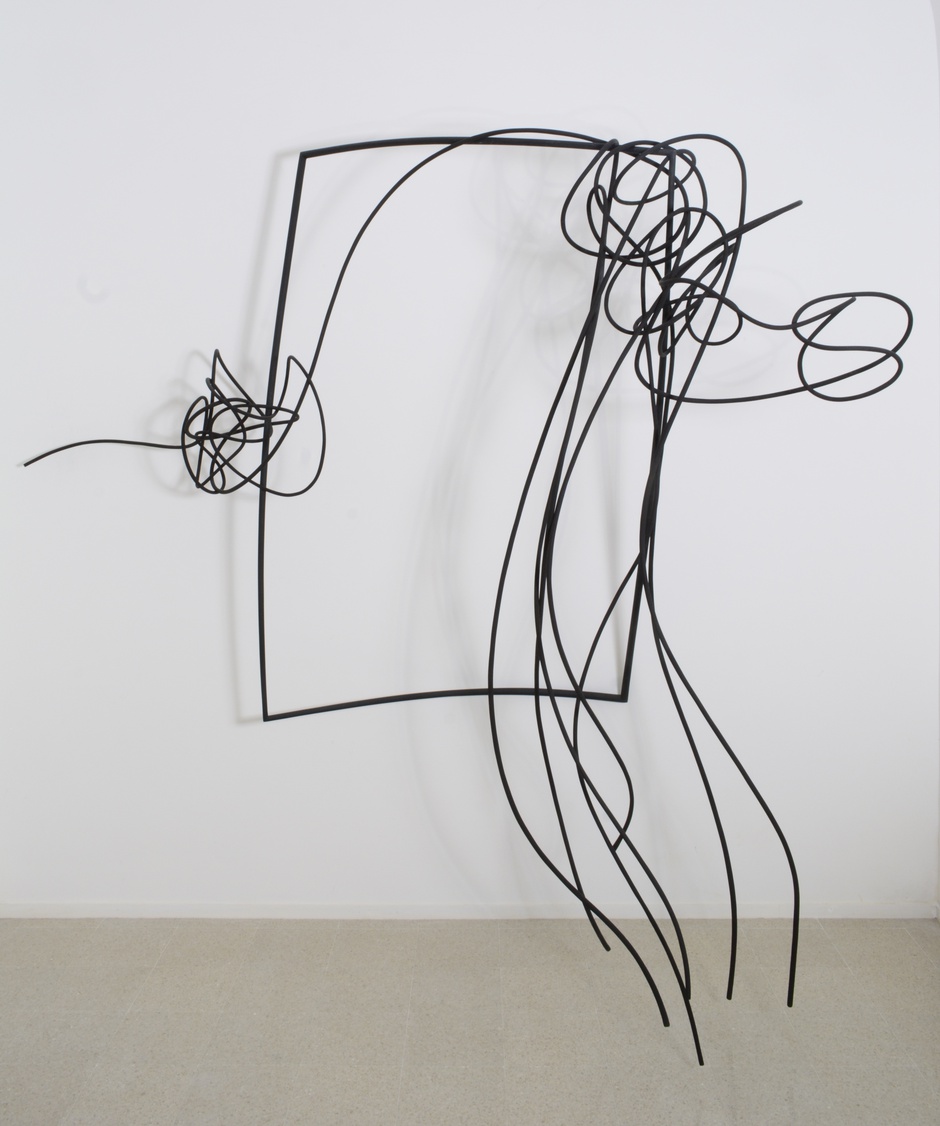
Roberto Almagno: ‘Col guinzaglio tra le dita II’, 2015 – wood
For all the contemporary centrality of concept and thought, there’s still an innate satisfaction in mastery of a medium. Two artists currently demonstrate that through the assurance with which they make materials behave unexpectedly. Italian sculptor Roberto Almagno (rosenfeld porcini to 13 Feb) pretty much draws in wood, using fallen tree branches, which he smooths back and moulds using a combination of fire and water, then paints matt grey. His forms have recently become increasingly baroque and on the face of it, unarboreal. Their balance is also remarkable, as becomes clear once you notice that ‘The Leash between the Fingers II’ pivots on just one touchpoint with the wall. Add variety, shadow play and spiritual undertones and ‘Suspended in Space’ is an impressive show. Merete Rasmussen has a comparable mastery of ceramics, building complex and surprisingly large forms out of coiled stoneware. Rasmussen characterises herself as being ‘intrigued by the idea of a continuous surface’ and exploring ‘soft but precise curves, sharp edges, concave surfaces shifting to convex’ and ‘the strength of an inner space’. It would be easy to assume that the Dane’s intensely coloured ceramics are bronze – and, in a new move which is by no means coincidental for a show at the foundry-affiliated Pangolin Gallery (to 16 Jan) – some of them are.
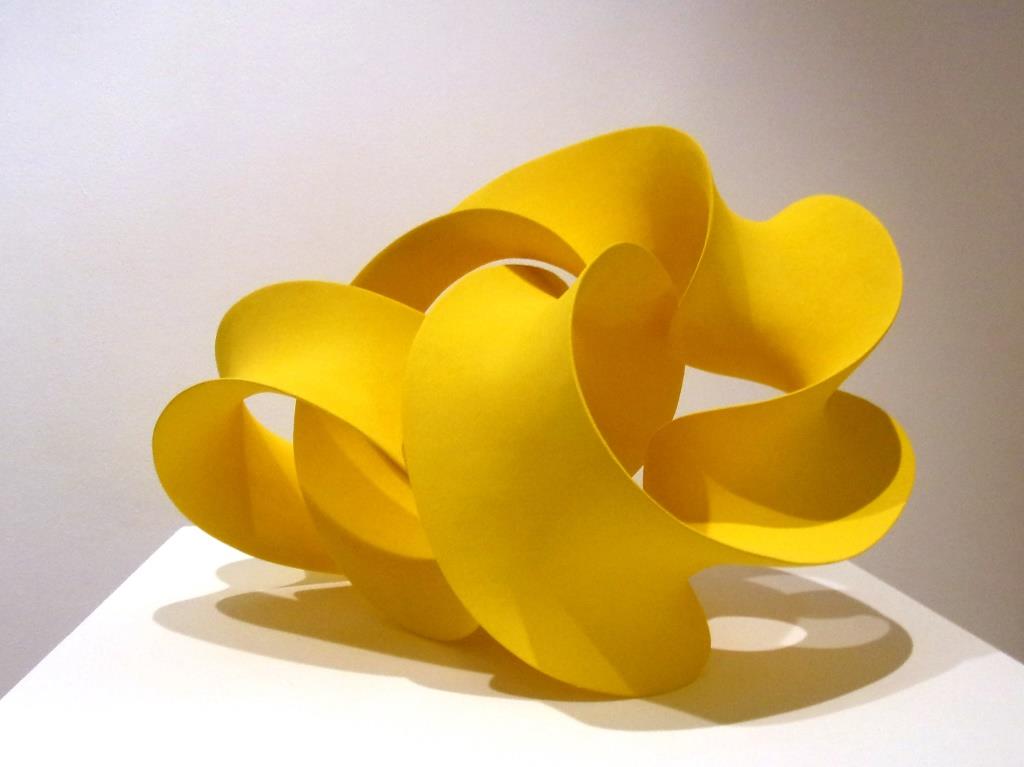
Merete Rasmussen: ‘Yellow Twisted Form’, 2015 – ceramic
Most days art Critic Paul Carey-Kent spends hours on the train, traveling between his home in Southampton and his day job in London. Could he, we asked, jot down whatever came into his head?

